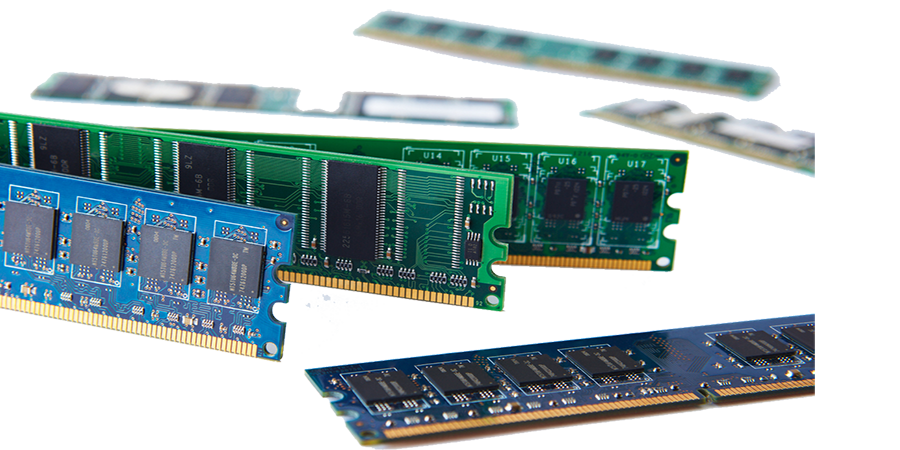We use cookies to offer you a better experience. For more information on how we use cookies you can read our Cookie and Privacy Policy.
What are Gigabytes of RAM?
April 13, 2020

If you're shopping for a new computer or putting one together yourself, you may have heard about RAM. But what exactly is a gigabyte of RAM? And how much RAM do you really need? In this guide, we’ll give you an idea about how a GB of RAM affects your daily computing routine.
What is RAM?
RAM stands for random access memory, and it’s where your PC puts data to access it quickly. It’s different than your hard-drive storage because RAM holds on to information just long enough to run, move, or close programs. If you were to shut down your computer right now, all of the information handled by RAM would be lost, like those last few unsaved changes to a Word document. The actual document would still exist on your long-term hard-drive storage, but the latest work would be lost.
RAM typically comes in “sticks.” If you hear someone say that they need another “stick of RAM,” they are referring to the format or shape of the RAM. This long, thin piece of hardware attaches directly to the computer’s motherboard by inserting into long, thin slots made specifically for the RAM. The sticks can come in a variety of sizes, from less than 1GB up to 16GB. Computers can have 1, 2, or more slots for RAM, and it is possible to change out your RAM in order to upgrade your computer.
What is a gigabyte of RAM?
Each stick of RAM has a set amount it can store, as indicated by 1GB, 2GB, and so on. What does the GB stand for? This is short-hand for a “gigabyte,” a measurement of data that equals roughly 1 billion bytes. How much is this in terms we understand? According to Netflix, an hour of high-definition video streaming uses 3GB of data. So, 20 minutes of HD streaming uses about 1GB of data [1]. You can also use 1GB of data to hold about 600 standard resolution photos, 700,000 pages of text, or 16 hours of music.
Why RAM matters
If you only need to read and write data to RAM for a short time, what’s the big deal about how big it is? Turns out it really is a big deal. If you don’t have enough RAM, the speed of your computer will be affected, even if you have a very fast and modern processor.
Since RAM serves so many tasks at one time, intense games or heavy video editing can easily use up modest amounts of RAM. You need to have RAM available since every time you access anything from the long term memory, it needs to sit temporarily in the RAM. Your computer use will suffer as a result of not having enough RAM free.
To quickly resolve some of the most irritating performance problems, you may consider adding more RAM to your PC. The signs that you need more RAM include:
- Sluggish gameplay
- Freezing programs
- Blue circle that swirls round and round while waiting for programs to open
If you have a top-notch CPU with a compatible graphics card, then it’s likely a RAM issue. Fortunately, RAM isn’t a difficult thing to upgrade for most desktop computers. It’s much more affordable than buying a new computer, and some laptops can be easily upgraded as well, especially those designed for gaming.
How much RAM do you really need?
This is a tricky question to answer since different people need different things. Here's a breakdown of some common tasks and the minimum RAM you'd probably want to do these tasks without lag or interruption:
- Competitive online gaming: 16GB to 32GB
- Casual offline or online gaming: 8GB to 16GB
- Editing and rendering photos, videos, or 3D graphics: 8GB to 16GB
- Browsing the web: 4GB to 8GB
- Streaming movies and music from online services: 4GB to 8GB
- Basic office tasks, such as creating Word documents or checking emails: 2GB to 4GB
Most modern laptops and desktops come with a minimum of 8GB, but there are some basic models of netbooks and student laptops that come with just 2GB. However, browsing uses more resources these days given the visual nature of most websites, so it's recommended to go for at least 4GB of RAM when you make your computer purchasing decision.
Shopping tips for RAM
If in doubt, your best bet is to round up to the next level of RAM if your budget can handle it. Since technology advances so quickly and applications and programs seem to use more and more resources with each update, you’ll never regret getting more RAM. Very rarely do gamers say, “I think there’s way too much RAM on this desktop PC!”
While adding RAM on your own is affordable, it can be difficult with some laptops. Buying more than you need when the computer is built is the easiest way to game, create, and enjoy your favorite movies for a long, long while.
You may also look into the differences between DDR4 (Double Data Rate Fourth Generation Synchronous Dynamic Random-Access Memory) compared to other types of RAM. This high-performance option is the newest in the line of RAM choices and gives you better overall speed with less power consumption. It’s considered to be very stable and may be easier on your computer over time, especially if you game. Just make sure that whatever RAM you pick is compatible with your other components. It’s best to use a tool like PCPartPicker to make sure you don’t buy the wrong thing.
Finally, when buying a computer or laptop online, you may be given the option to upgrade RAM on a given model before checking out. Look at the available options and compare them to those guidelines listed above. If you know that you'll be using your computer or laptop for video editing, for example, get the RAM you'll need now. Not only will you save time over having to do the upgrade yourself, but you'll also have the full protection of the manufacturer's warranty on the RAM since it comes with the original build.
Accessories and RAM
Consider the peripherals or games you’ll use when picking how much RAM you install. Check the specifications of anything you buy to be sure your computer meets the minimum RAM requirements. Many games will share a minimum vs a recommended RAM amount. If the game requires 8GB of RAM minimum, for example, your computer should have that or the game won’t work well. You may forget that you saved a little bit at checkout in the frustration of laggy gameplay in pretty short order.
About the Author: Linsey Knerl is a contributing writer for HP® Tech Takes. Linsey is a Midwest-based author, public speaker, and member of the ASJA. She has a passion for helping consumers and small business owners do more with their resources via the latest tech solutions.






